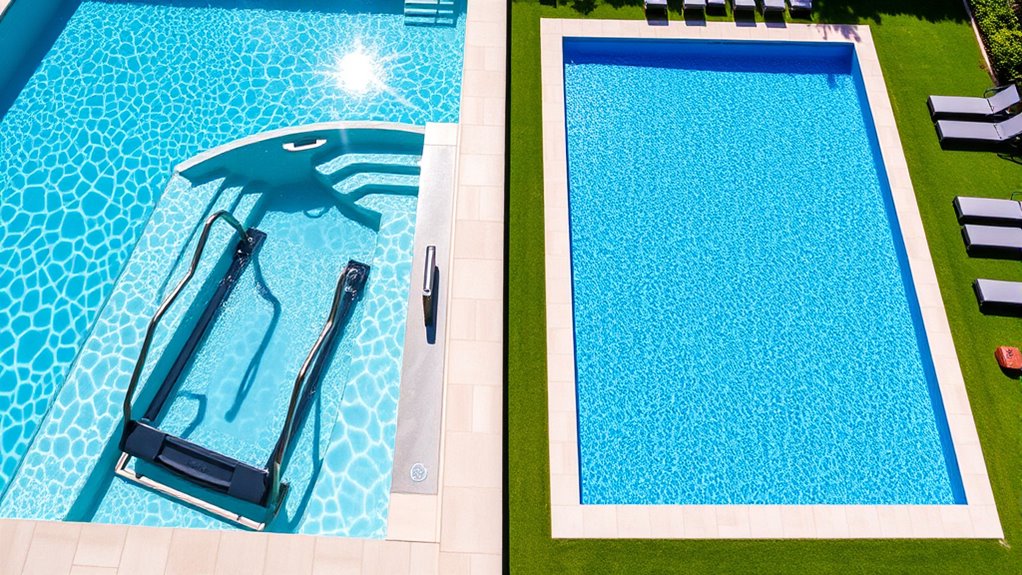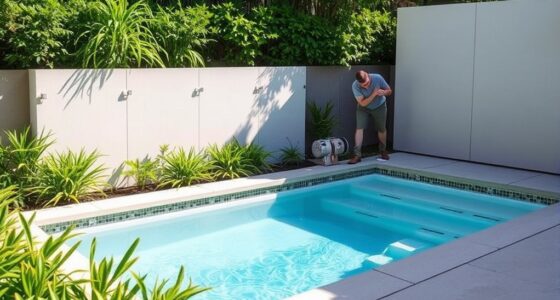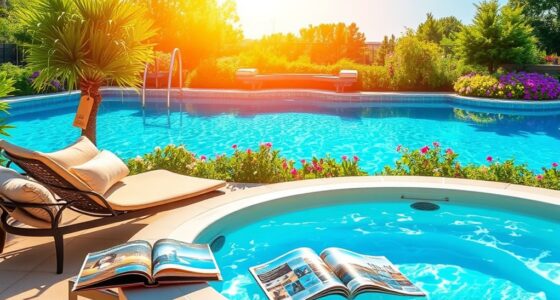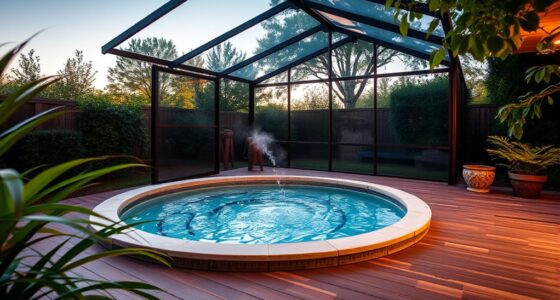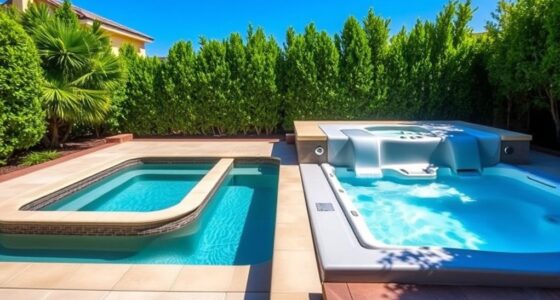A swim spa offers a compact, versatile alternative to a traditional pool, perfect for exercise, hydrotherapy, and low maintenance, especially if space is limited. You’ll enjoy easier cleaning, lower ongoing costs, and adjustable jets for targeted therapy. While traditional pools provide more space for socializing and recreation, they require more time and money for upkeep. To discover which option best fits your lifestyle and budget, explore the details further.
Key Takeaways
- Swim spas are more space-efficient and easier to maintain than traditional pools, ideal for limited areas.
- Traditional pools offer larger recreational space but require higher upfront costs and extensive ongoing maintenance.
- Swim spas provide adjustable hydrotherapy jets and combined exercise/relaxation benefits with lower operational costs.
- Traditional pools are better for social gatherings but involve more complex cleaning, chemical balancing, and seasonal upkeep.
- Investment in a swim spa balances convenience, health benefits, and lower long-term expenses compared to larger, traditional pools.

When deciding between a swim spa and a traditional pool, it’s important to understand how each option suits your lifestyle and space. A swim spa combines the features of a pool and a hot tub, offering a compact, all-in-one solution that allows you to swim against a counter-current or relax in warm, soothing water. If you’re seeking hydrotherapy benefits, a swim spa can be a great choice because the adjustable jets provide targeted massage and muscle relief. This therapeutic aspect is less common in standard pools unless you add specialized equipment, which can increase costs and complexity. With a swim spa, you get the convenience of both exercise and hydrotherapy in a smaller footprint, making it ideal if you want health benefits without the hassle of maintaining a large pool. Additionally, the security features of modern eSIM technology can help protect your connected devices while managing your pool’s automation systems remotely.
Speaking of maintenance requirements, swim spas generally demand less upkeep compared to traditional pools. They are smaller, so cleaning and chemical balancing take less time and effort. Many models come with advanced filtration systems that reduce the need for frequent cleaning, and some have self-cleaning features that further simplify maintenance. Traditional pools, especially larger ones, require more extensive cleaning, regular chemical treatments, and seasonal upkeep, such as winterizing in colder climates. The complexity of maintaining a traditional pool can be a deterrent for some homeowners, and the ongoing costs for chemicals, filtration, and equipment can add up over time.
However, it’s worth considering that swim spas, while easier to maintain, still need regular attention to keep the water clean and safe. The initial investment for a swim spa can be comparable to a smaller pool, but the ongoing operational costs are typically lower due to reduced size and simpler systems. Conversely, traditional pools involve higher upfront costs for installation and larger ongoing expenses for maintenance, chemicals, and repairs. If you prioritize convenience and hydrotherapy benefits in a smaller space, a swim spa may serve you better. But if you want a larger area for socializing and don’t mind the maintenance effort, a traditional pool might be more suitable. Ultimately, your choice should align with your lifestyle, budget, and how much time you’re willing to dedicate to upkeep.
Frequently Asked Questions
How Long Does a Typical Swim Spa Last Before Needing Replacement?
A typical swim spa lasts around 10 to 20 years before needing replacement, depending on durability factors and material lifespan. You can extend its longevity by regular maintenance, proper chemical balance, and addressing issues promptly. High-quality materials like acrylic or fiberglass tend to last longer, while cheaper options may wear out sooner. Your careful upkeep guarantees your swim spa remains functional and enjoyable for years to come.
Are There Specific Maintenance Requirements Unique to Swim Spas?
You need to regularly check your swim spa’s water chemistry to keep it safe and clear. Unlike traditional pools, swim spas often have compact filtration systems that require more frequent maintenance, such as cleaning or replacing filters. You should also monitor chemical levels closely and run the filtration system daily. Proper upkeep guarantees your swim spa stays sanitary, extends its lifespan, and provides a comfortable swimming environment.
Can a Swim Spa Be Installed Indoors or Only Outdoors?
Think of a swim spa as a versatile puzzle piece—you can fit it indoors or outdoors. Indoor installation is possible if you guarantee proper ventilation and waterproofing, but outdoor limitations include exposure to weather and temperature fluctuations. You have the flexibility to choose based on your space and climate, making it a convenient option for year-round use. Just keep in mind the specific requirements for indoor setups to avoid issues.
What Are the Energy Efficiency Differences Between Pools and Swim Spas?
You’ll find that swim spas generally have lower energy consumption than traditional pools because their smaller size and advanced insulation effectiveness help retain heat better. These features make swim spas more energy-efficient, especially with modern covers and technology that reduce heat loss. While pools require more energy to warm and maintain, swim spas’ compact design and insulation help you save on energy costs over time.
How Do Seasonal Weather Changes Affect the Use of Each?
Like the changing seasons, your pool or swim spa feels the weather impact. In colder months, a traditional pool might be harder to enjoy without extra heating, while swim spas often come with integrated heating, making year-round use easier. Seasonal climate influences your choice, affecting maintenance and comfort. You’ll find swim spas offer more flexibility, but both require adjustments to maximize their use during varying weather conditions.
Conclusion
Imagine stepping into your backyard, the water shimmering under the sun, whether it’s the sleek swirl of a swim spa or the classic allure of a traditional pool. Both offer invigorating escapes, but knowing the pros, cons, and costs helps you choose what’s right for you. Think of it like selecting a trusted friend—each has its own charm and benefits. Whichever you pick, your backyard will become a haven of relaxation and fun for years to come.
